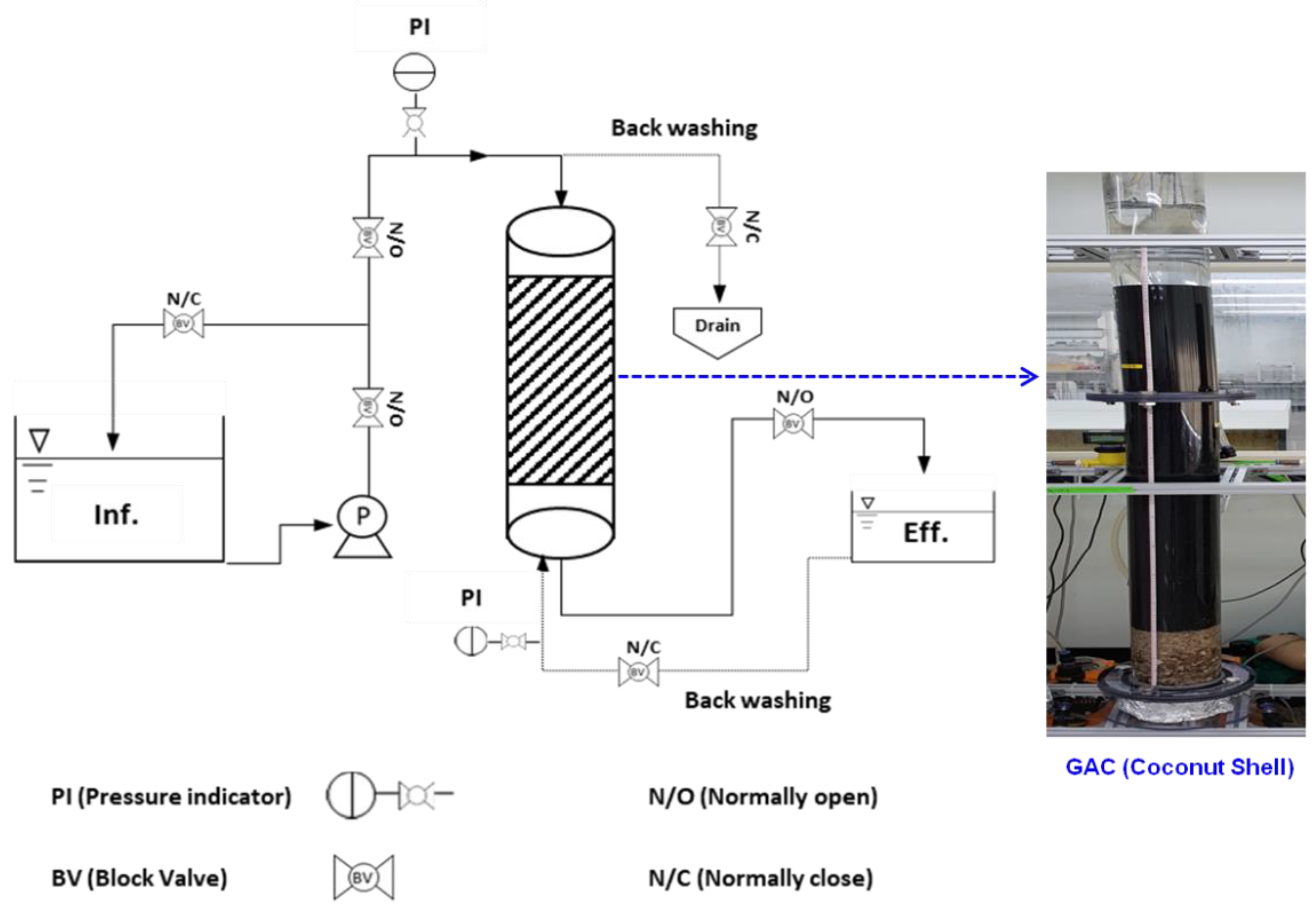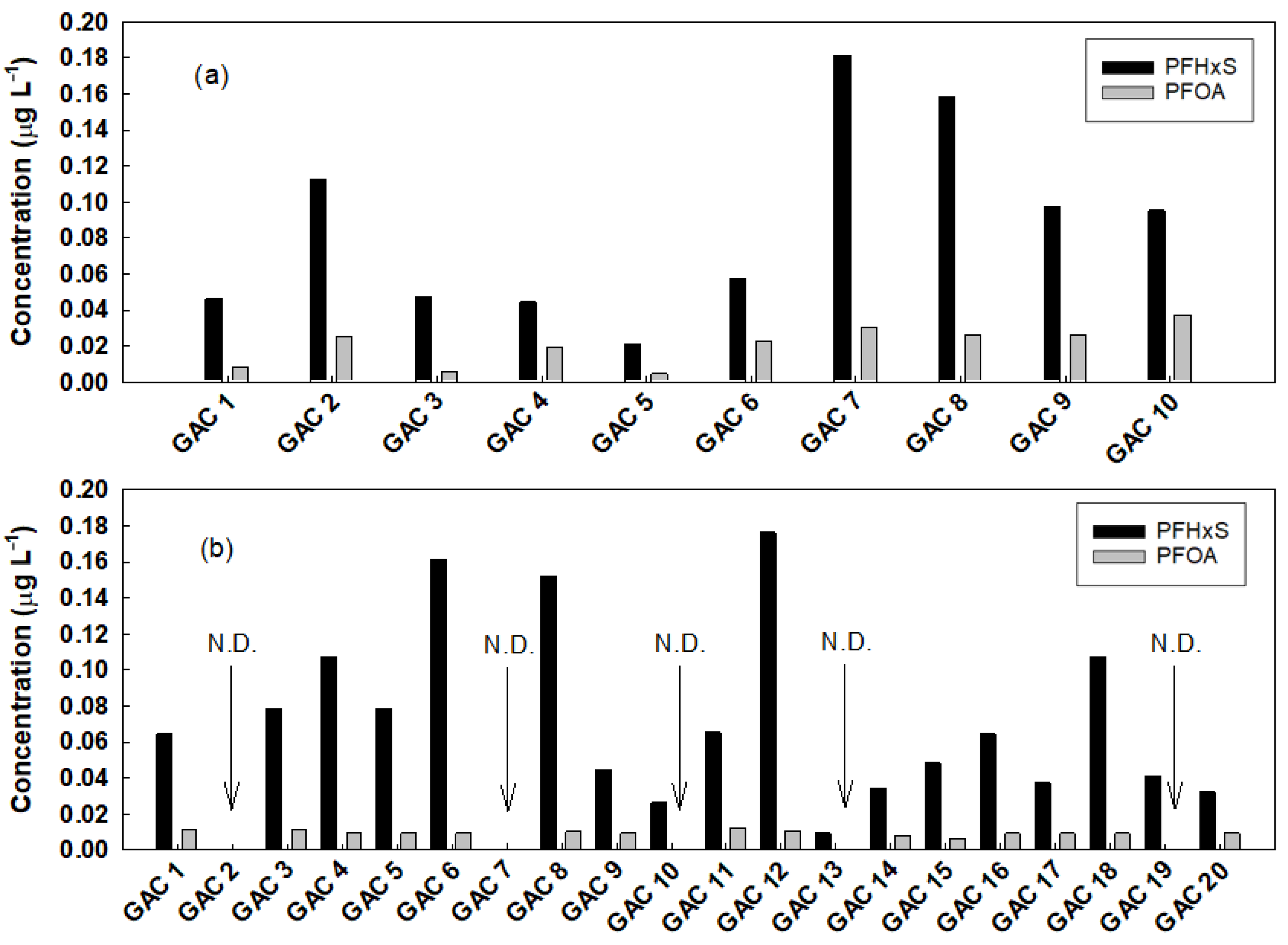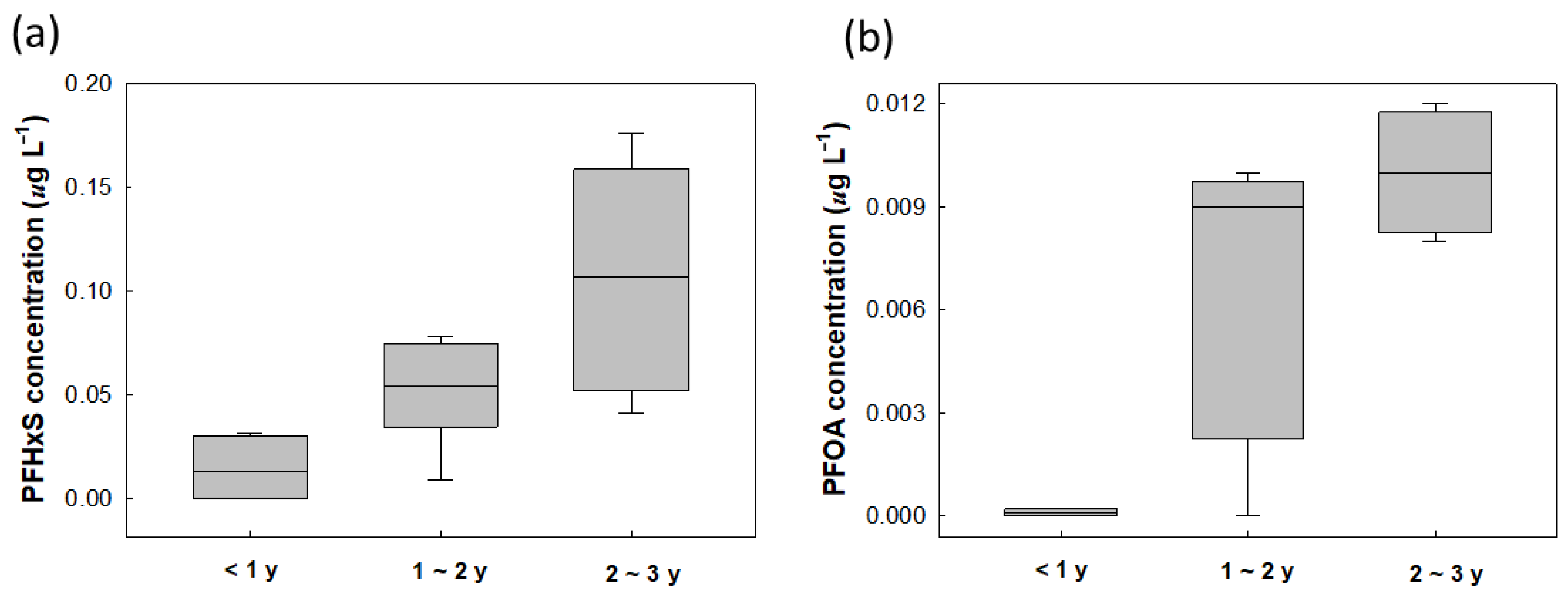Different Adsorption Behavior between Perfluorohexane Sulfonate (PFHxS) and Perfluorooctanoic Acid (PFOA) on Granular Activated Carbon in Full-Scale Drinking Water Treatment Plants
Abstract
1. Introduction
2. Materials and Methods
2.1. Sample Collection and Experimental Procedures
2.2. Materials
2.3. Analysis
3. Results and Discussion
3.1. Behavior and Fate of PFCs in DWTPs
3.2. Effect of GAC Regeneration and Replacement on PFC Removal
3.3. Determination of a GAC Replacement Cycle for the Removal of PFCs
4. Conclusions
Author Contributions
Funding
Institutional Review Board Statement
Informed Consent Statement
Data Availability Statement
Conflicts of Interest
References
- Luo, Y.; Guo, W.; Ngo, H.H.; Nghiem, L.D.; Hai, F.I.; Zhang, J.; Liang, S.; Wang, X.C. A review on the occurrence of micropollutants in the aquatic environment and their fate and removal during wastewater treatment. Sci. Total Environ. 2014, 473–474, 619–641. [Google Scholar] [CrossRef] [PubMed]
- Margot, J.; Rossi, L.; Barry, D.A.; Holliger, C. A review of the fate of micropollutants in wastewater treatment plants. Wiley Interdiscip. Rev. Water 2015, 2, 457–487. [Google Scholar] [CrossRef]
- Du, Z.; Deng, S.; Bei, Y.; Huang, Q.; Wang, B.; Huang, J.; Yu, G. Adsorption behavior and mechanism of perfluorinated compounds on various adsorbents—A review. J. Hazard. Mater. 2014, 274, 443–454. [Google Scholar] [CrossRef]
- Fujii, S.; Polprasert, C.; Tanaka, S.; Lien, N.P.H.; Qiu, Y. New POPs in the water environment: Distribution, bioaccumulation and treatment of perfluorinated compounds—a review paper. J. Water Supply: Res. Technol. 2007, 56, 313–326. [Google Scholar] [CrossRef]
- Stahl, T.; Mattern, D.; Brunn, H. Toxicology of perfluorinated compounds. Environ. Sci. Eur. 2011, 23, 1. [Google Scholar] [CrossRef]
- Giesy, J.P.; Kannan, K. Global Distribution of Perfluorooctane Sulfonate in Wildlife. Environ. Sci. Technol. 2001, 35, 1339–1342. [Google Scholar] [CrossRef] [PubMed]
- Son, H.-J.; Yoo, S.-J.; Jang, S.-H. The Evaluation of Adsorption Characteristics of Perfluorinated Compounds (PFCs) in GAC Process Using Continuous Column Adsorption Test. J. Korean Soc. Environ. Eng. 2013, 35, 206–212. [Google Scholar] [CrossRef]
- Prevedouros, K.; Cousins, I.T.; Buck, R.C.; Korzeniowski, S.H. Sources, Fate and Transport of Perfluorocarboxylates. Environ. Sci. Technol. 2006, 40, 32–44. [Google Scholar] [CrossRef]
- Suja, F.; Pramanik, B.K.; Zain, S.M. Contamination, bioaccumulation and toxic effects of perfluorinated chemicals (PFCs) in the water environment: A review paper. Water Sci. Technol. 2009, 60, 1533–1544. [Google Scholar] [CrossRef]
- Rahman, M.F.; Peldszus, S.; Anderson, W.B. Behaviour and fate of perfluoroalkyl and polyfluoroalkyl substances (PFASs) in drinking water treatment: A review. Water Res. 2014, 50, 318–340. [Google Scholar] [CrossRef] [PubMed]
- Lin, A.Y.-C.; Panchangam, S.C.; Lo, C.-C. The impact of semiconductor, electronics and optoelectronic industries on downstream perfluorinated chemical contamination in Taiwanese rivers. Environ. Pollut. 2009, 157, 1365–1372. [Google Scholar] [CrossRef]
- Lein, N.P.H.; Fujii, S.; Tanaka, S.; Nozoe, M.; Tanaka, H. Contamination of perfluorooctane sulfonate (PFOS) and perfluorooctanoate (PFOA) in surface water of the Yodo River basin (Japan). Desalination 2008, 226, 338–347. [Google Scholar] [CrossRef]
- Nakayama, S.; Strynar, M.J.; Helfant, L.; Egeghy, P.; Ye, X.; Lindstrom, A.B. Perfluorinated Compounds in the Cape Fear Drainage Basin in North Carolina. Environ. Sci. Technol. 2007, 41, 5271–5276. [Google Scholar] [CrossRef] [PubMed]
- Becker, A.M.; Gerstmann, S.; Frank, H. Perfluorooctane surfactants in waste waters, the major source of river pollution. Chemosphere 2008, 72, 115–121. [Google Scholar] [CrossRef] [PubMed]
- Loos, R.; Locoro, G.; Huber, T.; Wollgast, J.; Christoph, E.H.; De Jager, A.; Gawlik, B.M.; Hanke, G.; Umlauf, G.; Zaldívar, J.-M. Analysis of perfluorooctanoate (PFOA) and other perfluorinated compounds (PFCs) in the River Po watershed in N-Italy. Chemosphere 2008, 71, 306–313. [Google Scholar] [CrossRef] [PubMed]
- Kudo, N.; Kawashima, Y. Toxicity and toxicokinetics of perfluorooctanoic acid in humans and animals. J. Toxicol. Sci. 2003, 28, 49–57. [Google Scholar] [CrossRef] [PubMed]
- Belkouteb, N.; Franke, V.; McCleaf, P.; Köhler, S.; Ahrens, L. Removal of per- and polyfluoroalkyl substances (PFASs) in a full-scale drinking water treatment plant: Long-term performance of granular activated carbon (GAC) and influence of flow-rate. Water Res. 2020, 182, 115913. [Google Scholar] [CrossRef]
- EPA. Fact Sheet PFOA & PFOS Drinking Water Health Advisories; EPA 800-F-16-003; EPA: Washington, DC, USA, 2016. [Google Scholar]
- Kim, M.; Seok, K.; Kim, Y.; Lee, S. Efficient Sorption and Removal of Perflouroalkyl Substance (PFASs) on Appliable Sorbents in Drinking Water Treatment Plant; K-Water: Daejeon, Korea, 2019. [Google Scholar]
- Schröder, H.F.; Jose, H.; Gebhardt, W.; Moreira, R.; Pinnekamp, J. Biological wastewater treatment followed by physicochemical treatment for the removal of fluorinated surfactants. Water Sci. Technol. 2010, 61, 3208–3215. [Google Scholar] [CrossRef]
- Lim, C.; Kim, H.; Han, G.; Kim, H.; Hwang, Y.; Kim, K. Behavior of perfluorinated compounds in advanced water treatment plant. J. Korean Soc. Water Wastewater 2020, 34, 323–334. [Google Scholar] [CrossRef]
- Vecitis, C.D.; Park, H.; Cheng, J.; Mader, B.T.; Hoffmann, M.R. Treatment technologies for aqueous perfluorooctanesulfonate (PFOS) and perfluorooctanoate (PFOA). Front. Environ. Sci. Eng. China 2009, 3, 129–151. [Google Scholar] [CrossRef]
- Lampert, D.J.; Frisch, M.A.; Speitel, G.E. Removal of Perfluorooctanoic Acid and Perfluorooctane Sulfonate from Wastewater by Ion Exchange. Pr. Period. Hazard. Toxic Radioact. Waste Manag. 2007, 11, 60–68. [Google Scholar] [CrossRef]
- Tang, C.Y.; Fu, Q.S.; Robertson, A.P.; Criddle, C.S.; Leckie, J.O. Use of Reverse Osmosis Membranes to Remove Perfluorooctane Sulfonate (PFOS) from Semiconductor Wastewater. Environ. Sci. Technol. 2006, 40, 7343–7349. [Google Scholar] [CrossRef]
- Tang, C.Y.; Fu, Q.S.; Criddle, C.S.; Leckie, J.O. Effect of Flux (Transmembrane Pressure) and Membrane Properties on Fouling and Rejection of Reverse Osmosis and Nanofiltration Membranes Treating Perfluorooctane Sulfonate Containing Wastewater. Environ. Sci. Technol. 2007, 41, 2008–2014. [Google Scholar] [CrossRef] [PubMed]
- Son, H.-J.; Yoom, H.-S.; Jung, J.-M.; Jang, S.-H. Application of On-Line SPE-LC/MSD to Measure Perfluorinated Compounds (PFCs) in Water. J. Korean Soc. Environ. Eng. 2013, 35, 75–83. [Google Scholar] [CrossRef][Green Version]
- Eschauzier, C.; Beerendonk, E.; Scholte-Veenendaal, P.; De Voogt, P. Impact of Treatment Processes on the Removal of Perfluoroalkyl Acids from the Drinking Water Production Chain. Environ. Sci. Technol. 2012, 46, 1708–1715. [Google Scholar] [CrossRef] [PubMed]
- Takagi, S.; Adachi, F.; Miyano, K.; Koizumi, Y.; Tanaka, H.; Watanabe, I.; Tanabe, S.; Kannan, K. Fate of Perfluorooctanesulfonate and perfluorooctanoate in drinking water treatment processes. Water Res. 2011, 45, 3925–3932. [Google Scholar] [CrossRef] [PubMed]
- Szajdzinska-Pietek, E.; Gębicki, J.L. Pulse radiolytic investigation of perfluorinated surfactants in aqueous solutions. Res. Chem. Intermed. 2000, 26, 897–912. [Google Scholar] [CrossRef]
- Holliday, M.D. Comparison of the PFAS Adsorption Capabilities of a Coconut Shell Based Granular Activated Carbon and a Bituminous Coal Based Granular Activated Carbon; AFIT: Columbus, OH, USA, 2020. [Google Scholar]
- Zhang, D.; Luo, Q.; Gao, B.; Chiang, S.-Y.D.; Woodward, D.; Huang, Q. Sorption of perfluorooctanoic acid, perfluorooctane sulfonate and perfluoroheptanoic acid on granular activated carbon. Chemosphere 2016, 144, 2336–2342. [Google Scholar] [CrossRef]
- Yu, Q.; Zhang, R.; Deng, S.; Huang, J.; Yu, G. Sorption of perfluorooctane sulfonate and perfluorooctanoate on activated carbons and resin: Kinetic and isotherm study. Water Res. 2009, 43, 1150–1158. [Google Scholar] [CrossRef]






| Substrate | Coconut Shell |
|---|---|
| Adsorption capacity of iodine | 1058 mL g−1 |
| MB decolorization | 180 mL g−1 |
| Specific surface area | 804.0 m2 g−1 |
| Micropore volume | 0.47 mL g−1 |
| Density | 0.5 g L−1 |
| Amount of activated carbon | 5 kg |
| HPLC Operating Condition | MS/MS Operating Conditions | ||
|---|---|---|---|
| Column | Thermo Hypersil GOLD 50 mm × 2.1 mm × 1.9 µm | Ionization Mode | ESI 1(-) |
| Column oven temperature | 30 °C | Curtain gas | 30 psi |
| Buffer A | 5 mM ammonium acetate water (0.02% Formic acid) | Collision gas | 12 psi |
| Buffer B | 100% methanol | Ion source gas 1 | 50 psi |
| Flow | 0.4 mL min−1 | Ion source gas 2 | 50 psi |
| Injection | 20 μL | Ion source voltage | −4500 V |
| Run time | 10 min | Interface temp. | 600 °C |
| Acquisition | MRM 2 mode | ||
| Coal-Based GAC | Coconut-Shell Based GAC | |||
|---|---|---|---|---|
| PFHxS | PFOA | PFHxS | PFOA | |
| Total adsorption amount (mg/ton-AC) | 276.2 | 40.2 | 1137.9 | 209.5 |
| CUR (g/d) | 0.051 | 0.050 | 0.058 | 0.037 |
| DWTP | Parameters | Average | Median | S.D. | Min | Max | |
|---|---|---|---|---|---|---|---|
| M1 | Inf. | PFHxS (μgL−1) | 0.023 | 0.000 | 0.075 | 0.000 | 0.340 |
| Eff. | 0.052 | 0.028 | 0.052 | 0.007 | 0.231 | ||
| Inf. | PFOA (μgL−1) | 0.013 | 0.010 | 0.008 | 0.000 | 0.041 | |
| Eff. | 0.007 | 0.005 | 0.009 | 0.000 | 0.034 | ||
| M2 | Inf. | PFHxS (μgL−1) | 0.023 | 0.000 | 0.076 | 0.000 | 0.344 |
| Eff. | 0.054 | 0.031 | 0.061 | 0.006 | 0.267 | ||
| Inf. | PFOA (μgL−1) | 0.011 | 0.008 | 0.008 | 0.000 | 0.037 | |
| Eff. | 0.007 | 0.005 | 0.008 | 0.000 | 0.034 | ||
Publisher’s Note: MDPI stays neutral with regard to jurisdictional claims in published maps and institutional affiliations. |
© 2021 by the authors. Licensee MDPI, Basel, Switzerland. This article is an open access article distributed under the terms and conditions of the Creative Commons Attribution (CC BY) license (http://creativecommons.org/licenses/by/4.0/).
Share and Cite
Park, Y.-G.; Lee, W.H.; Kim, K. Different Adsorption Behavior between Perfluorohexane Sulfonate (PFHxS) and Perfluorooctanoic Acid (PFOA) on Granular Activated Carbon in Full-Scale Drinking Water Treatment Plants. Processes 2021, 9, 571. https://doi.org/10.3390/pr9040571
Park Y-G, Lee WH, Kim K. Different Adsorption Behavior between Perfluorohexane Sulfonate (PFHxS) and Perfluorooctanoic Acid (PFOA) on Granular Activated Carbon in Full-Scale Drinking Water Treatment Plants. Processes. 2021; 9(4):571. https://doi.org/10.3390/pr9040571
Chicago/Turabian StylePark, Yong-Gyun, Woo Hyoung Lee, and Keugtae Kim. 2021. "Different Adsorption Behavior between Perfluorohexane Sulfonate (PFHxS) and Perfluorooctanoic Acid (PFOA) on Granular Activated Carbon in Full-Scale Drinking Water Treatment Plants" Processes 9, no. 4: 571. https://doi.org/10.3390/pr9040571
APA StylePark, Y.-G., Lee, W. H., & Kim, K. (2021). Different Adsorption Behavior between Perfluorohexane Sulfonate (PFHxS) and Perfluorooctanoic Acid (PFOA) on Granular Activated Carbon in Full-Scale Drinking Water Treatment Plants. Processes, 9(4), 571. https://doi.org/10.3390/pr9040571







